
ESPAÑOL
Cliente: Autoridades Locales
Arquitecto-Ingeniero: Santiago Calatrava
Tipo: Puentes atirantados
Localizados cerca de la zona industrial de Mancasale, los puentes de Reggio Emilia fueron encargados por las autoridades locales de Bolonia al arquitecto e ingeniero Santiago Calatrava para un proyecto de gran envergadura que vendría a solucionar diferentes enlaces y comunicaciones a las afueras de esta importante ciudad. El arquitecto solucionó el proyecto mediante tres puentes atirantados, dos de ellos gemelos y situados a ambos lados de un enorme puente central. El puente sur se sitúa cerca de una enorme rotonda mientras que el principal, que salva la Autopista A1 perpendicularmente, dispone de 50 metros de altura y esta situado en medio de los otros dos; este puente central está compuesto por un enorme arco atirantado de acero con dos ojos característicos en sus extremos; otro puente gemelo similar al de la rotonda se sitúa al otro lado.
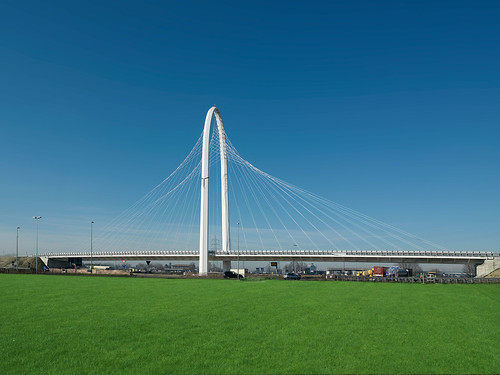
El enorme arco del puente central, que cuenta con más de 220 metros de longitud, logra sustentar el tablero mediante pares de cables atirantados de acero anclados a la parte inferior de la cubierta y en el mismo eje del puente. Este enorme arco, aparte de hacer de puerta de entrada para la importante ciudad, tiene la particularidad de que la fuerza axial de los tirantes de acero hace que se transmitan las cargas a ambos extremos del puente y de esta forma no se desplome el arco. Los otros dos tramos importantes del puente a ambos lados del central, disponen de un arco gemelo vertical que recuerda al proyecto de los puentes de Margaret Hunt Hill, en Dallas, USA, un proyecto que se encuentra aún en fase de construcción en la actualidad.
Para el diseño de los dos arcos gemelos verticales superiores en altura que el puente central, ya que disponen de 70 metros de altura cada uno, Calatrava se inspiró en la figura humana, ya que da la sensación de que el arco es la figura humana y los cables son los brazos que sustentan el tablero. Las dos pasarelas con arcos gemelos tienen un ancho de 15 metros para un tramo de 179 metros de largo y están realizados íntegramente en acero pintado en blanco. El proyecto se completa con una nueva Estación Ferroviaria que destacará en el horizonte cuando termine su construcción, ya que se basa fundamentalmente en una cubierta de color blanco impoluto que simboliza las ondas marinas, motivada esta por una escultura realizada por el arquitecto algunos años antes para el Museo de Meadows, en Dallas, Texas, USA.
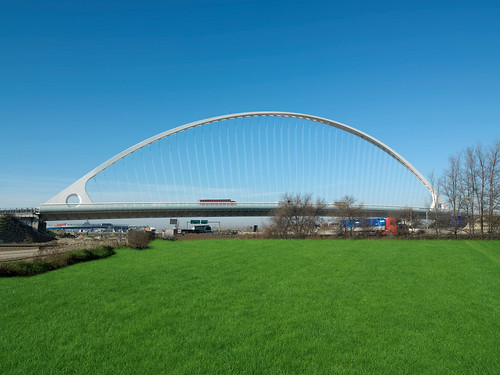
ENGLISH
Client: Local Authorities
Architect-Engineer: Santiago Calatrava
Type: Cable-stayed bridge
Located near the industrial zone Mancasale, Reggio Emilia bridges were commissioned by local authorities in Bologna to the architect and engineer Santiago Calatrava for a major project that would solve various communications links and on the outskirts of this important city. The architect solved the project by three cable-stayed bridges, two of them twins, and on both sides of a large central bridge. The south bridge is located near a big roundabout while the principal, which saves the A1 motorway at right angles, there are 50 meters high and is located in the middle of the other two main bridge consists of a huge steel tied arch characteristic with two eyes at their ends, another twin bridge similar to the roundabout is situated on the opposite side.
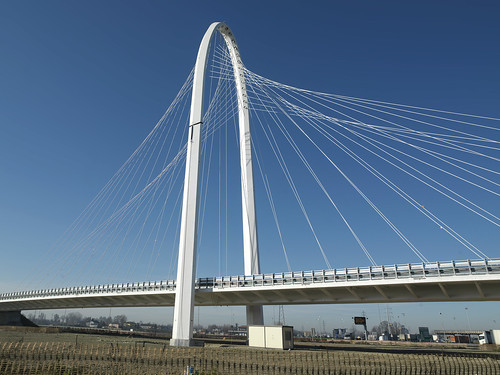
The huge central arch of the bridge, which has more than 220 meters long, able to support the board by pairs of cable-stayed steel cables anchored to the bottom of the deck and on the same axis of the bridge. This huge arch, apart from making a gateway to the major city, has the peculiarity that the axial force of steel braces makes loads are transmitted to both ends of the bridge and thus does not fall over the bow. The other two major sections of the bridge on both sides of the central arch have a vertical twin project reminiscent of Margaret Hunt Hill bridge in Dallas, USA, a project that is still under construction at present.
For the design of two twin arches in vertical height above the central bridge, because they have height of 70 meters each, Calatrava was inspired by the human figure, as it gives the impression that the bow is the human figure and cables are the arms that support the board. The two twin arched bridges have a width of 15 meters for a length of 179 meters long and are made entirely of steel painted white. The project is completed with a new railway station will outline in the horizon when his construction, as it relies heavily on a pristine white cover that symbolizes the sea waves, driven by a sculpture that the architect for some years before Meadows Museum in Dallas, Texas, USA.
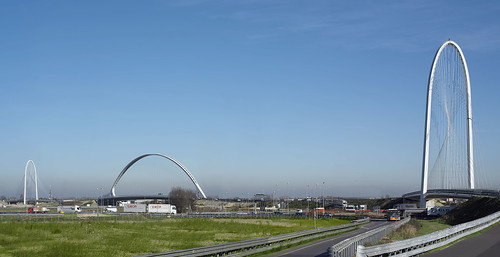
"Images Reggio Emilia Bridges" Copyright © Daniele Domenicali
Website: www.danieledomenicali.com
"Text" Copyright © José Miguel Hernández Hernández
Editor, Escritor y Fotógrafo de Arquitectura /
Publisher, Writer and Architectural Photographer
Todos los derechos reservados / All rights reserved
http://www.jmhdezhdez.com/
References / Referencias
Santiago Calatrava-Turning Torso
Bellisco Ediciones, Madrid, 2008
by José Miguel Hernández Hernández
Español - English
+info
Related articles / Artículos relacionados
Puente del Alamillo
Sevilla, Andalucía, Spain
Pasarela Campo Volantín
Bilbao, Spain
Aeropuerto de Sondica
Bilbao, Spain
HSB Turning Torso
Malmo, Sweden

Sundial Bridge
Redding, California, USA
MUY IMPORTANTE!!! VERY IMPORTANT!!!
Deja tu comentario sobre este reportaje al pie de este post donde dice "Publicar un comentario en la entrada"; me será de gran valor para seguir mejorando este sitio web y te contestaré con la mayor brevedad posible... Muchas gracias!
No obstante, si te ha resultado interesante este reportaje y también el Blog en general, por favor, no dudes en hacerte Fan de la página de Fans del Blog de José Miguel Hernández Hernández en Facebook aquí
Nota importante: Una vez que hayas entrado en la página de Fans del Blog en Facebook, con sólo hacer click en el botón de "Me gusta", a partir de ese momento estarás al tanto de todos los nuevos reportajes interesantes relacionados con la Arquitectura y la Ingeniería que aquí se vayan publicando para no perder ningún detalle...
También puedes suscribirte por e-mail (te llegaría un e-mail con el enlace de cada artículo en el mismo momento en que sea publicado), o bien también puedes seguir el Blog a través de Twitter aquí
Nos vemos en el Blog!
Leave a comment on this story at the bottom of this post where it says "Post a comment in the entry", I will prove invaluable to further improve this website and I will answer as soon as possible .. . Thank you very much!
However, if you this story was interesting and the blog in general, please do not hesitate to make Fan Fans of the Blog page José Miguel Hernández Hernández on Facebook here
Very important: Once you enter the page Blog fan of Facebook, simply click on the button Like "From that moment you are aware of all new interesting stories related to the Architecture and Engineering are published here to avoid losing any detail ...
Can also subscribe by e-mail (I would e-mail with a link to each item in the same time it is published), or you can follow through Blog Twitter here
See you at the Blog!
HOME GEOGRAPHY ARCHITECTURE ENGINEERING SKYSCRAPERS
BRIDGES BUILDINGS TOWERS PUBLICATIONS ABOUT ME CONTACT
Copyright © José Miguel Hernández Hernández
Editor, Escritor y Fotógrafo de Arquitectura /
Publisher, Writer and Architectural Photographer
http://www.jmhdezhdez.com/
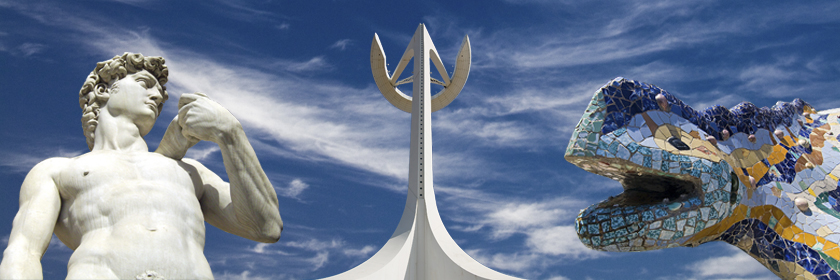



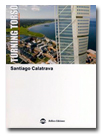

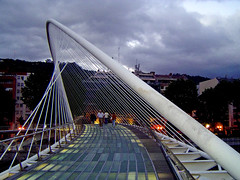




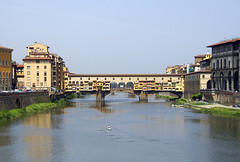




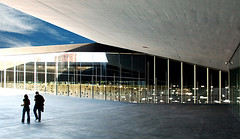



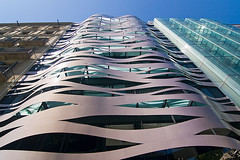




No hay comentarios:
Publicar un comentario